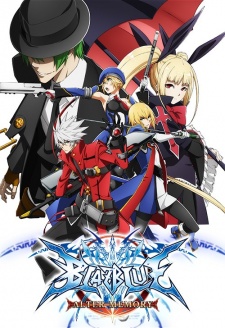
Back in my sophomore year of high school, around the time that I discovered anime in earnest for the first time, a friend got me interested in a number of fighting games that had a distinctly anime visual style to them, and with comparable story and character development to boot. While I ultimately ended up back at my old favorite Super Smash Bros. Melee two years later, a new game ported over from the Japanese arcades called Blazblue: Continuum Shift really pulled me into that world of fighting games, between the slick combos and fun voice acting, and of course the brilliant way it wove its characters’ disparate storylines together to create an actual world. Here was Ragna the Bloodedge, feared terrorist cloaked in shadow and a brilliant red coat, facing off against the forces of good as they're misled by the sinister chain user Hazama. We find the ice swordsman Jin, the robotic girl Lambda-11, the young puppeteer Carl, the terrifying amorphous blob Arakune, and many others who struggle for their convictions. Ironically for a fighting game, known for only having flat 2D stages with no difference save the background, there were countless dimensions to Blazblue.
And so I admit that I have a heavy bias when I review Blazblue: Alter Memory, but to be fair, it barely gives enough of the story and details present in Continuum Shift to be engaging to a newcomer to the franchise. If you haven’t yet played the game, then Alter Memory will serve you no purpose other than to give a rough plot summary of the games. Of course I also implore fans of the game to stay as far away from this anime as humanly possible, but I would advise newcomers to avoid it even more, were that even possible. If you want an understanding of the visual style and character dynamics at play, as well as the superb soundtrack and—if you’re interested—a strong example of the fighting game genre, there are plenty of gameplay videos available online, so I would suggest you spend a couple hours there first before reading on and finding out that those few hours were enough. Alternatively, press on with me and save yourself the time altogether.
Alter Memory is absolutely devoid of entertainment value, and despite sharing a name and central plot with its fighting game cousin, the similarities end where the game’s charm begins. I mentioned Ragna and Hazama before, as they serve as central protagonist and central antagonist in the series, but in the show they are the only two relevant characters. Everyone else exists on the periphery, to push the plot along and make these two look better. Lambda-11, formerly a terminator with the consciousness of a robot Ragna once befriended trapped deep inside, now pops in only briefly to completely break character and pose deep philosophical questions to Ragna after they spend a day frolicking through the fields, and of course he answers the questions succinctly and perfectly as if he’d rehearsed for hours. The mischievous cat-person Taokaka and her ninja teacher Bang serve the same comic relief role as in the game, but also break character to stroke Ragna’s ego. Hazama’s machinations are more true to his character and atmosphere in the game, but these moments are fleeting indeed.
They forced a hot springs episode out of a wanted terrorist and a group of his supposed enemies, because what the franchise was really missing was the breasts. They provided at least two or three filler episodes in a show with fewer episodes than character routes in the original work, and barely managed to cover the central one. The plot involving Arakune, who was turned into his current horrific form by his experiments with his lover, the exotic Faye-Ling, and her subsequent assistance of Hazama’s ultimate goals was barely mentioned, and ultimately relegated to the background, along with plots such as Carl and his father, the defense duo of the inventor Kokonoe and her robotic giant Tager, and the delicate friendship between Jin, his coworker Noel, and Noel’s old classmate Tsubaki. Instead we get a lot of annoying interactions with the tiny vampire Rachel Alucard and her sarcastic butler Valkenhayn R. Hellsing, as well as the tiny hooded girl Platinum, and the tiny squirrely girl Makoto. It seems fairly obvious how they chose to market Alter Memory with all the annoying tiny girls that received less attention in the games—the more prudent choice by far.
A note on the music. The Blazblue franchise has some of the most outstanding music of any game I have ever played, and so when an original game song came on in the first fight scene I got plenty excited. It turns out they cut down the original game songs to fit the battle sequences, which rarely lasted more than a minute or two. Alternatively they threw in a few remixes, which would have been a nice mix-up for the fans had the remixes not been more bland and generic than their authentic counterparts. More to the point, how did they manage to put so few fight scenes into the show that these differences became apparent is beyond me. They shouldn’t be confined to the genre of the game, but if the fighting game medium brought out the best in the character conflicts, the visuals, the music, the narrative, and the ultimate tension in this well-crafted tapestry, then I hate to admit that the anime medium pulled a single thread out of the tapestry, spray-painted it a sensual pink, and left it on the ground to mildew for the rest of time.